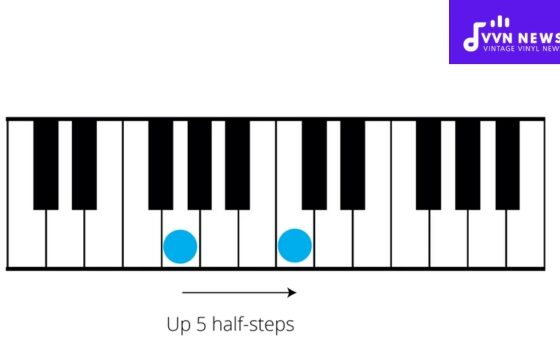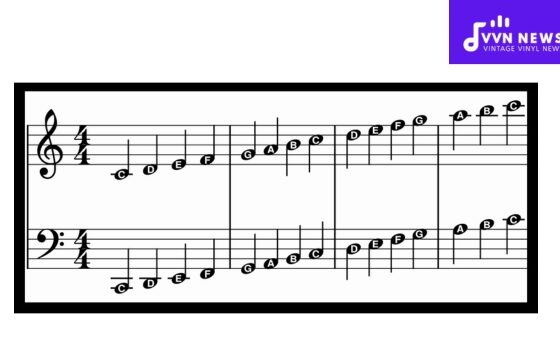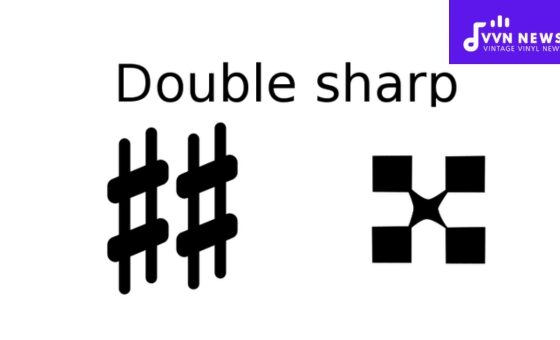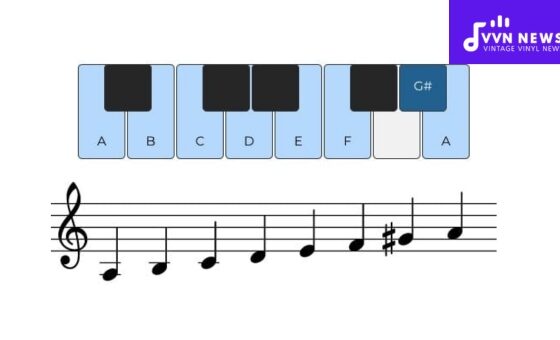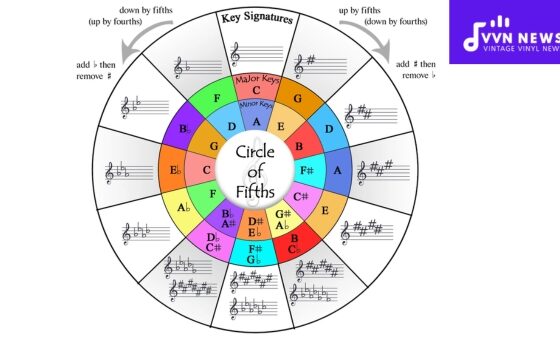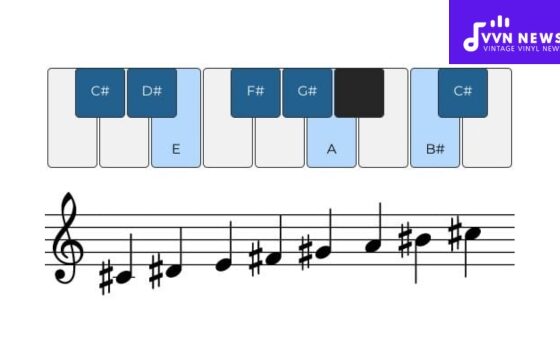Have you ever encountered a piece of music that had a symbol resembling a lowercase ‘b’ next to a note and wondered what it means? This symbol indicates “A Flat Music Note,” and understanding its role is crucial for anyone diving into the world of music theory.
Think of the flat note as the gentle dip in a road, slightly lowering the pitch you’re used to, creating a unique sound that gives richness and color to musical compositions.
Grasping the concept of flat notes can unlock new depths in your musical journey, whether you’re playing an instrument or simply savoring your favorite tunes.
It’s not just about knowing where they are; it’s about feeling how they contribute to the emotional tapestry of a song.
So let’s demystify this essential musical element together and discover how it affects the emotional nuance in melodies that resonate with listeners far and wide.
How is the Musical Note A Flat Illustrated on a Staff in Sheet Music?
When you gaze at a piece of sheet music, A Flat (notated as Ab) is symbolized by a flat sign (♭), which mirrors a stylized lowercase ‘b.’
It’s placed on the staff before the note head, specifically on the fourth line in treble clef, showing where an “A” would typically be played.
A Flat instructs you to play or sing a semitone lower.
In the bass clef, you’ll locate the flat sign slightly arrayed; here, it sits on the second-to-top space.
Since clefs dictate where notes fall on the staff, these visual cues are instrumental for performers to interpret and adjust their pitches accurately.
Recognizing Ab is simplified by spotting this distinctive symbol—an essential step in mastering musical literacy.
Locating A Flat on Pianos and Keyboards

On a piano or keyboard, A Flat (Ab) is found to the left of the A key. It’s typically the black key nestled between the A and G keys, sharing its position with G Sharp (G#), thanks to enharmonic equivalence. To locate Ab:
- Identify the group of three black keys.
- Focus on the first two black keys.
- Press the second black key, which is Ab.
Discovering Ab is easy once you establish these visual markers—simply look for that cluster of three and home in on that crucial second note.
On a standard 88-key piano, there will be multiple instances of Ab across the entire instrument, repeating every octave.
The precise, consistent placement ensures a quick find every time you play.
Also Read: 25 Bestselling Artists Of All Time [Musical Icons That Broke Records]
Accidentals Associated with the A Flat Music Note
When it comes to music, accidentals play a crucial role in modifying the pitch of notes.
Specifically for the A Flat (Ab) note, it’s important to understand accidentals such as the sharp (♯), flat (♭), and natural (♮). These symbols directly impact how you play or interpret this note.
Accidentals
- The Flat (♭): The most directly related accidental to an A Flat is, of course, the flat symbol. It tells you to lower the A natural by a half step. On a piano, that means moving from an A key to the black key immediately to its left.
- The Sharp (♯): Though not directly associated with playing an A Flat, the sharp can interact with this note when used in musical contexts such as key changes or modulation. For instance, if you see a G♯ in a piece where Ab is used, remember these are enharmonically equivalent—meaning they are played on the same key on an instrument but represented differently depending on the musical context.
- The Natural (♮): This symbol cancels any previous accidentals. So if you see an Ab followed by an A♮ later in a piece, you’ll know it’s time to return to playing the white key A natural on your instrument.
Musicians need to differentiate these symbols as they have a significant impact on the performance and interpretation of pieces that include variations around Ab, enhancing melodic expression and harmonic richness.
How is the A Flat Music Note Represented in Different Musical Clefs?

When reading music, you’ll encounter the A Flat Note rendered in various clefs.
Each clef determines the pitch range for the staff and thus influences where the A Flat note is located.
Let’s explore how A Flat is notated across these clefs to help you quickly recognize and play this note.
Treble Clef
In the treble clef, which typically governs higher-pitched instruments like the violin and flute, A Flat is found on the second space from the top of the staff. It appears just below G and above F.
Bass Clef
The bass clef, commonly associated with lower-pitched instruments such as tuba or bass guitar, shows A Flat on the second space from the bottom of the staff. This positions it above G flat and below B flat.
Alto Clef
Often used for viola music, the alto clef places A Flat directly on top of the middle line of the staff. It’s nestled between G flat and B flat.
Tenor Clef
For instruments like cello or trombone, you might see a tenor clef. Here, A Flat falls right above middle C – it’s a ledger line below the bottom line of this staff.
Mezzo-Soprano Clef
Though far less common today, mezzo-soprano clef makes A Flat sit just above middle C, on a space slightly lower than its position in Alto Clef.
Soprano Clef
In historical applications such as Gregorian chant transcriptions, soprano clefs might be used. For A Flat, it’s one ledger line higher than in Mezzo-Soprano Clef: right beneath that first bottom line of your staff.
Also Read: 25 Best Rappers Of All Time [Lyricists Who Shaped Hip Hop]
Baritone Clef
Similar to Tenor and Bass Clefs but designed for baritone voice or instruments like euphonium; in this context, A Flat also takes place on a ledger line below this low-centric stave.
By familiarizing yourself with how A Flat is indicated across different musical contexts – each unique to its family of instruments – you’ll bolster your fluency in music theory and performance alike.
Understanding Musical Scales Starting with A Flat
Embarking on the artistry of scales, particularly those beginning with an A Flat, is akin to stepping into a new dimension of audible textures.
A Flat (Ab) serves as the first note—the tonic—in a sequence that outlines both major and minor soundscapes.
The A Flat Major Scale
The A Flat Major Scale is known for its warm and mellow sound. It consists of the following notes:
- A Flat (Ab)
- B Flat (Bb)
- C
- D Flat (Db)
- E Flat (Eb)
- F
- G
These notes compose a scale that artists often use to convey comfort and consolation within their melodies.
The A Flat Natural Minor Scale
Contrasting to its major counterpart, the A Flat Natural Minor Scale exudes a tone rich with introspection and complexity:
- A Flat (Ab)
- B Flat (Bb)
- C♭ – Enharmonically B natural
- D Flat (Db)
- E♭♭ – Enharmonically D natural
- F♭ – Enharmonically E natural
- G♭ – Enharmonically F sharp or G flat
Intimate and profound, this minor scale explores the deeper realms of human emotion within musical storytelling.
Also Read: 25 Best Drummers Of All Time [Rhythm Legends Who Drove The Beat]
Utilizing Scales in Compositions
Delving into scales that start on Ab, you’d find they are integral to compositions spanning genres from classical to popular music—a testament to their versatility and emotional impact.
When considering scales that commence with an A flat, it is essential to understand both the major and minor variations—and how each uniquely colors your auditory canvas.
Musical Modes Starting with A Flat

Musical modes are essentially scales that provide different sonic palettes and emotional flavors to compositions.
When you start a mode with an A Flat (Ab) music note, you transport musicians and listeners alike into a distinctive sonic landscape.
The Ionian Mode (The Major Scale)
Starting with the Ab note, the Ionian mode in Ab would give us the Ab Major Scale: Ab – Bb – C – Db – Eb – F – G.
This scale exudes a cheerful and stable atmosphere, perfect for conveying feelings of happiness and resolution.
The Dorian Mode
Next is the Dorian mode, which begins a whole step down from Ionian. When applied to Ab, it shifts to G Dorian: G – Ab – Bb – C – D – E – F.
This scale has a more jazzy feel, slightly melancholic yet hopeful.
The Phrygian Mode
Following, there’s the mysterious Phrygian mode starting on F: F – Gb (or F#) – Ab. It continues with Bb-C-Db-Eb-F. Known for its exotic flair, it serves well in pieces aiming for tension or an ethnic vibe.
The Lydian Mode
The enchanting Lydian mode, beginning on Eb for our case: Eb-F-G-Ab-Bb-C-D-Eb, features an increased fourth scale degree creating bright and dreamy soundscapes that are both uplifting and complex.
The Mixolydian Mode
With its bluesy undertones, the Mixolydian mode rooted at Db goes Db-Eb-F-Gb-Ab-Bb-C-Db. Its flattened seventh gives it a groovy character that’s cooler in temperament than its major counterpart.
Also Read: 19 Best-selling Albums Of All Time [Music’s Greatest Hits]
The Aeolian Mode (The Natural Minor Scale)
Reflecting somber moods is the Aeolian mode, or better known as the natural minor scale. Start from Bb for Aeolian in Ab: Bb-C-Db-Eb-F-G-Ab. It’s perfect when you need to express sorrow or pensiveness.
The Locrian Mode
Finally, there’s Locrian—a rare and dark-sounding mode—rooted at C here: C-Db-Eb-F-Gb-Ab-Bb-C.
It’s distinctively dissonant due to its diminished fifth degree, making it fit haunting or unsettling themes flawlessly.
Each mode brings its unique emotional color rooted in that initial A Flat note and spirals out into vast musical expressions.
By cycling through these modes starting on an A Flat Note, you can uncover rich soundscapes that are waiting to be explored in your musical endeavors.
The Sound Frequency of A Flat Music Note
The A Flat music note (written as A♭) resonates at a specific pitch or frequency. In music, standard pitch tuning—also known as concert pitch—sets A4 (the A above middle C) to 440 Hz.
Relative to this, the A♭4 typically vibrates at about 415.30 Hz. However, if you move one octave down to A♭3, the frequency halves, giving you approximately 207.65 Hz.
These frequencies are essential for musicians as they ensure consistency and harmony across various instruments tuned to the same standard in an ensemble.
Understanding and recognizing the unique tonal quality that comes from this flat note’s frequency supports musicians in tuning their instruments correctly and blending within orchestral settings or solo performances.
Also Read: 20 Best Eq Pedals For Perfect Tone [Shape Your Guitar Sound]
FAQs About A Flat Music Note
What exactly does a flat note mean in music?
A flat note, denoted by the symbol ♭, lowers the pitch of the given note by one half-step or semitone.
Can a note be ‘double flat’?
Yes, a double flat further lowers the pitch of a note by two half-steps and is represented by two flat symbols (♭♭) together.
Is A Flat the same as G Sharp on the piano?
In most contexts, yes. On a piano, A Flat and G Sharp are enharmonic, meaning they share the same key but are used differently according to the musical context.
How do I find A Flat on my guitar?
You can find A Flat on the lowest string (sixth string) by playing at the fourth fret.
Does a flat affect all similar notes in a musical sheet?
If placed in the key signature, it affects all similar notes throughout; if it’s accidental, it only affects that note for the duration of the measure it’s in.
Conclusion
A Flat Music Note is a subtle yet powerful element in the fabric of the music.
Understanding its role and impact on compositions can elevate your appreciation and performance of musical pieces.
Whenever you encounter this note, remember it’s more than just a symbol; it’s an invitation to explore deeper sonic landscapes.
With each occurrence of an A Flat, let your awareness of its expressive potential enrich your musical experiences.

